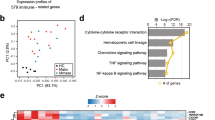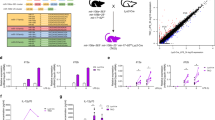Abstract
Leprosy provides a model to investigate mechanisms of immune regulation in humans, given that the disease forms a spectrum of clinical presentations that correlate with host immune responses. Here we identified 13 miRNAs that were differentially expressed in the lesions of subjects with progressive lepromatous (L-lep) versus the self-limited tuberculoid (T-lep) disease. Bioinformatic analysis revealed a significant enrichment of L-lep–specific miRNAs that preferentially target key immune genes downregulated in L-lep versus T-lep lesions. The most differentially expressed miRNA in L-lep lesions, hsa-mir-21, was upregulated in Mycobacterium leprae–infected monocytes. By directly downregulating Toll-like receptor 2/1 heterodimer (TLR2/1)-induced CYP27B1 and IL1B expression as well as indirectly upregulating interleukin-10 (IL-10), hsa-mir-21 inhibited expression of the genes encoding two vitamin D–dependent antimicrobial peptides, CAMP and DEFB4A. Conversely, knockdown of hsa-mir-21 in M. leprae–infected monocytes enhanced expression of CAMP and DEFB4A and restored TLR2/1-mediated antimicrobial activity against M. leprae. Therefore, the ability of M. leprae to upregulate hsa-mir-21 targets multiple genes associated with the immunologically localized disease form, providing an effective mechanism to escape from the vitamin D–dependent antimicrobial pathway.
This is a preview of subscription content, access via your institution
Access options
Subscribe to this journal
Receive 12 print issues and online access
$209.00 per year
only $17.42 per issue
Buy this article
- Purchase on Springer Link
- Instant access to full article PDF
Prices may be subject to local taxes which are calculated during checkout






Similar content being viewed by others
References
Ridley, D.S. & Jopling, W.H. Classification of leprosy according to immunity. A five-group system. Int. J. Lepr. Other Mycobact. Dis. 34, 255–273 (1966).
Yamamura, M. et al. Defining protective responses to pathogens: cytokine profiles in leprosy lesions. Science 254, 277–279 (1991).
Salgame, P. et al. Differing lymphokine profiles of functional subsets of human CD4 and CD8 T cell clones. Science 254, 279–282 (1991).
Montoya, D. et al. Divergence of macrophage phagocytic and antimicrobial programs in leprosy. Cell Host Microbe 6, 343–353 (2009).
Liu, P.T. et al. Toll-like receptor triggering of a vitamin D–mediated human antimicrobial response. Science 311, 1770–1773 (2006).
Liu, P.T. et al. Convergence of IL-1β and VDR activation pathways in human TLR2/1-induced antimicrobial responses. PLoS ONE 4, e5810 (2009).
Lu, T.X., Munitz, A. & Rothenberg, M.E. MicroRNA-21 is up-regulated in allergic airway inflammation and regulates IL-12p35 expression. J. Immunol. 182, 4994–5002 (2009).
Sheedy, F.J. et al. Negative regulation of TLR4 via targeting of the proinflammatory tumor suppressor PDCD4 by the microRNA miR-21. Nat. Immunol. 11, 141–147 (2010).
Adams, L.B. et al. The study of Mycobacterium leprae infection in interferon-γ gene–disrupted mice as a model to explore the immunopathologic spectrum of leprosy. J. Infect. Dis. 185 (suppl. 1), S1–S8 (2002).
Martinez, A.N. et al. Molecular determination of Mycobacterium leprae viability by use of real-time PCR. J. Clin. Microbiol. 47, 2124–2130 (2009).
Hansen, G.A. Undwersogelser angaende spedalskhedens arsager. Norsk. Mag. Laegevid 4, 1–88 (1874).
Peña, M.T. et al. Expression and characterization of recombinant interferon γ (IFN-γ) from the nine-banded armadillo (Dasypus novemcinctus) and its effect on Mycobacterium leprae–infected macrophages. Cytokine 43, 124–131 (2008).
Vachula, M., Holzer, T.J. & Andersen, B.R. Suppression of monocyte oxidative response by phenolic glycolipid I of Mycobacterium leprae. J. Immunol. 142, 1696–1701 (1989).
Neill, M.A. & Klebanoff, S.J. The effect of phenolic glycolipid-1 from Mycobacterium leprae on the antimicrobial activity of human macrophages. J. Exp. Med. 167, 30–42 (1988).
Tabouret, G. et al. Mycobacterium leprae phenolglycolipid-1 expressed by engineered M. bovis BCG modulates early interaction with human phagocytes. PLoS Pathog. 6, e1001159 (2010).
Clark-Curtiss, J.E. & Walsh, G.P. Conservation of genomic sequences among isolates of Mycobacterium leprae. J. Bacteriol. 171, 4844–4851 (1989).
Cremer, T.J. et al. MiR-155 induction by F. novicida but not the virulent F. tularensis results in SHIP down-regulation and enhanced pro-inflammatory cytokine response. PLoS ONE 4, e8508 (2009).
Liu, Z. et al. Up-regulated microRNA-146a negatively modulate Helicobacter pylori–induced inflammatory response in human gastric epithelial cells. Microbes Infect. 12, 854–863 (2010).
Sinsimer, D. et al. Mycobacterium leprae actively modulates the cytokine response in naive human monocytes. Infect. Immun. 78, 293–300 (2010).
Krutzik, S.R. et al. Activation and regulation of Toll-like receptors 2 and 1 in human leprosy. Nat. Med. 9, 525–532 (2003).
Roy, S. et al. Association of vitamin D receptor genotype with leprosy type. J. Infect. Dis. 179, 187–191 (1999).
Herrera, G. Vitamin D in massive doses as an adjuvant to the sulfones in the treatment of tuberculoid leprosy. Int. J. Lepr. 17, 35–42 (1949).
Rook, G.A.W. The role of vitamin D in tuberculosis. Am. Rev. Respir. Dis. 138, 768–770 (1988).
Crowle, A.J., Ross, E.J. & May, M.H. Inhibition by 1,25(OH)2-vitamin D3 of the multiplication of virulent tubercle bacilli in cultured human macrophages. Infect. Immun. 55, 2945–2950 (1987).
Munger, K.L., Levin, L.I., Hollis, B.W., Howard, N.S. & Ascherio, A. Serum 25-hydroxyvitamin D levels and risk of multiple sclerosis. J. Am. Med. Assoc. 296, 2832–2838 (2006).
Lappe, J.M., Travers-Gustafson, D., Davies, K.M., Recker, R.R. & Heaney, R.P. Vitamin D and calcium supplementation reduces cancer risk: results of a randomized trial. Am. J. Clin. Nutr. 85, 1586–1591 (2007).
Ahn, J. et al. Vitamin D–related genes, serum vitamin D concentrations and prostate cancer risk. Carcinogenesis 30, 769–776 (2009).
Silahtaroglu, A.N. et al. Detection of microRNAs in frozen tissue sections by fluorescence in situ hybridization using locked nucleic acid probes and tyramide signal amplification. Nat. Protoc. 2, 2520–2528 (2007).
Acknowledgements
We would like to thank G. Cheng, R. O'Connell, J. Krahenbuhl, R. Lahiri and B. Bloom for their helpful discussions. The live M. leprae was provided by the US National Hansen's Disease Programs through the generous support of the American Leprosy Missions and Society of St. Lazarus of Jerusalem. This work was supported by US National Institutes of Health grants AI 022553, AI 047868, AR 040312 and AI 073539. P.T.L. is supported by US National Institutes of Health K22 Career Development Award AI 85025. K.E. is supported by a postdoctoral grant from the Wenner-Gren Foundations (Sweden). We would like to thank M. Schibler and the University of California–Los Angeles, California NanoSystems Institute, Advanced Light Microscopy Core Facility for their assistance with the confocal studies.
Author information
Authors and Affiliations
Contributions
P.T.L. performed the experiments, supervised the project, analyzed the data and wrote the manuscript. M.W. performed the in situ hybridization experiments and a portion of the M. leprae infection, antimicrobial and monocyte transfection experiments. R.T. performed the microarray experiments. E.K. performed the bioinformatics analysis of the microarray data. K.E. performed the IL-10–related experiments. B.F. performed a portion of the M. leprae infection, antimicrobial and monocyte transfection experiments. M.D.M. performed a portion of the M. leprae infection and ligands experiments. A.V. performed a portion of the monocyte transfection experiments. T.H.R. and E.N.S. diagnosed patients with leprosy collected skin biopsy specimens. T.G.G. designed, supervised and performed bioinformatics analysis. R.L.M. supervised the project and wrote the manuscript.
Corresponding author
Ethics declarations
Competing interests
The authors declare no competing financial interests.
Supplementary information
Supplementary Text and Figures
Supplementary Figures 1–12, Supplementary Table 1, Supplementary Note and Supplementary Methods (PDF 782 kb)
Rights and permissions
About this article
Cite this article
Liu, P., Wheelwright, M., Teles, R. et al. MicroRNA-21 targets the vitamin D–dependent antimicrobial pathway in leprosy. Nat Med 18, 267–273 (2012). https://doi.org/10.1038/nm.2584
Received:
Accepted:
Published:
Issue Date:
DOI: https://doi.org/10.1038/nm.2584
This article is cited by
-
Attomolar sensitivity microRNA detection using real-time digital microarrays
Scientific Reports (2022)
-
Epigenetic interaction of microbes with their mammalian hosts
Journal of Biosciences (2021)
-
MicroRNAs regulate innate immunity against uropathogenic and commensal-like Escherichia coli infections in the surrogate insect model Galleria mellonella
Scientific Reports (2020)
-
Importance of the immune response to Mycobacterium leprae in the skin
Biomedical Dermatology (2018)
-
New insights into vitamin D anticancer properties: focus on miRNA modulation
Molecular Genetics and Genomics (2017)



